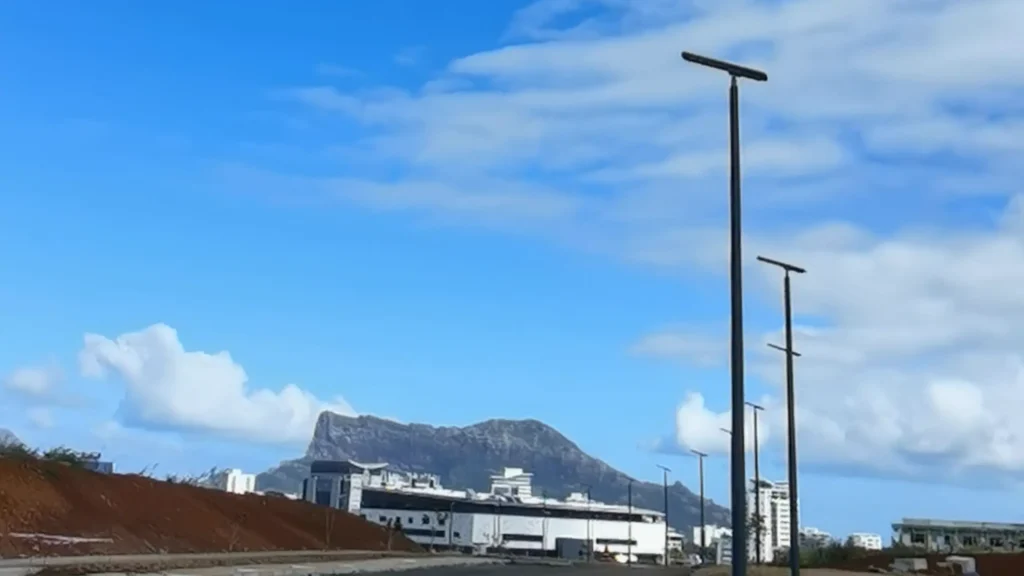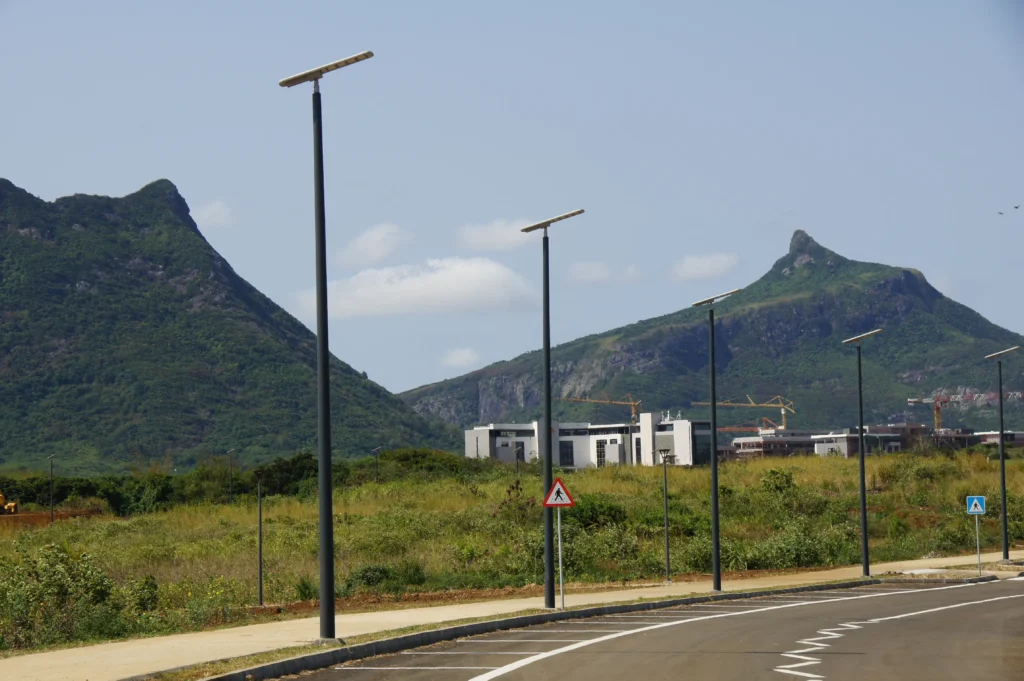Abstract
This case study presents an in-depth analysis of a successful deployment of Sresky Atlas series integrated solar street lights in a newly developed suburban district of Mauritius, aimed at establishing a modern and sustainable public lighting system.
1. Project Background and Requirements Analysis
1.1 Project Location and Macro Environment
Mauritius, a tropical island nation in the Indian Ocean, is renowned for its stunning natural landscapes and thriving tourism industry. In recent years, the country has actively promoted urbanization. The project site—a newly emerging suburban development zone—is currently undergoing rapid construction.
Climate Challenges: Located in the tropics, Mauritius experiences high temperatures year-round and a rainy season marked by frequent and prolonged rainfall. These conditions demand superior heat resistance, waterproofing, and long battery life for outdoor lighting systems.
Development Needs: As the area attracts residents and commercial investments, there is an urgent need for a reliable public lighting solution to enhance safety and regional appeal.
1.2 Core Needs Analysis
To support the overall development plan of the district, the local government outlined several core requirements:
-
Enhancing Public Safety: With rising occupancy, nighttime lighting is critical for resident safety and crime prevention.
-
Promoting Economic and Community Development: A robust lighting infrastructure attracts residents and commercial investors, boosts community vitality, and supports the district’s modern image.
-
Achieving Sustainable Development: Mauritius prioritizes environmental protection and green tourism. Solar lighting aligns with these goals by reducing dependence on the traditional grid and enhancing global standing.
-
Cost-Effectiveness and Grid Independence: The local grid may not yet be fully developed. Solar street lights eliminate the need for cables, reduce installation costs, and provide zero electricity fees, significantly lowering long-term municipal expenses.
II. Technical Solution Design: The High Adaptability of the Sresky Atlas Series
To meet the project’s requirements, the team conducted rigorous evaluations and selected the Sresky Atlas series of integrated solar street lights. This series combines advanced technology with high performance, perfectly aligning with Mauritius’ environmental and functional needs.
2.1 Product Selection and Key Technologies
Based on road width and lighting needs, the SSL-36 model was deployed to illuminate main and secondary roads. Core technologies include:
Core Technology 1: ALS2.4 Intelligent Light Decay Compensation System
-
Function: Automatically adjusts power consumption and optimizes light output, ensuring 100% lighting availability even after more than 10 consecutive rainy days.
-
Benefit: Addresses power failure issues during Mauritius’ rainy season, ensuring uninterrupted lighting and safety year-round.
Core Technology 2: TCS Intelligent Temperature Control System
-
Function: Monitors battery temperature in real time, optimizes charging/discharging efficiency, and extends battery lifespan to 1,500 cycles—outperforming standard lithium iron phosphate batteries.
-
Benefit: Effectively resists battery degradation under high temperatures, ensuring stable long-term operation.
Core Technology 3: PIR Smart Human Sensing
-
Function: A high-sensitivity PIR sensor with a 120° field of view and 8-meter range supports multiple lighting modes:
-
M1 Mode: Maintains 30% brightness during low-traffic periods, increasing to 100% upon motion detection for energy savings.
-
M3 Mode: Maintains 70% constant brightness for main roads, ensuring consistent performance.
-
-
Benefit: Enables energy optimization while ensuring safety, adapting to various usage scenarios.
2.2 Outstanding Product Performance
-
High Luminous Efficacy: Utilizes OSRAM LED chips with 230 lm/W, 5700K color temperature, and Ra >70, offering bright, clear white light to enhance visibility.
-
Durability and Protection: Aluminum alloy and PC housing, rated IP65 (water/dustproof) and IK08 (impact resistance), withstands tropical storms and impacts.
-
Efficient Solar Charging: Monocrystalline solar panels with 21%+ conversion efficiency maximize solar capture and reduce charging time.
-
Long Lifespan and Low Maintenance: Lithium batteries support 2,000 cycles. A modular design allows component-level maintenance on-site, reducing lifecycle costs. Includes a 3-year warranty.
3. On-site Challenges and Solutions
Challenge: Coordination with ongoing infrastructure projects (e.g., road and building construction) caused logistical overlaps.
Solution: The team optimized lamp post layout using scientific planning, road simulations, and light distribution curves to ensure uniform coverage.
Installation Efficiency: Modular design and standardized installation processes reduced the construction timeline and ensured timely delivery.
4. Project Outcomes and Impact
4.1 Social Value
-
Enhanced Public Safety: Atlas streetlights provide reliable lighting across roads and public areas, reducing nighttime traffic accidents and crime risks.
-
Stronger Community Engagement: A safe, well-lit environment fosters community interaction and boosts nighttime activity.
-
Modern Urban Aesthetics: The clean, consistent, high-tech appearance of solar streetlights helps shape a modern, attractive district image.
4.2 Economic and Environmental Value
-
Zero Electricity Costs: Atlas streetlights run entirely on solar power, eliminating the need for grid connections and reducing ongoing expenses.
-
Reduced Maintenance: High-quality materials and modular design lower the need for frequent maintenance, with a 3-year warranty ensuring long-term value.
-
Sustainable Development: The project reduces carbon emissions and supports Mauritius’ national strategy for green tourism and environmental sustainability.
Conclusion
The solar public lighting project in Mauritius’ suburban new district is a prime example of merging technological innovation with sustainability. By selecting the Sresky Atlas series, the project overcame harsh tropical conditions and delivered strong safety, economic, and environmental benefits. Featuring ALS2.4, TCS, and PIR technologies, the Atlas series provides all-weather lighting, long battery life, and energy efficiency—injecting modern vitality into the district and offering a valuable reference model for green urbanization worldwide.
Table of Contents

